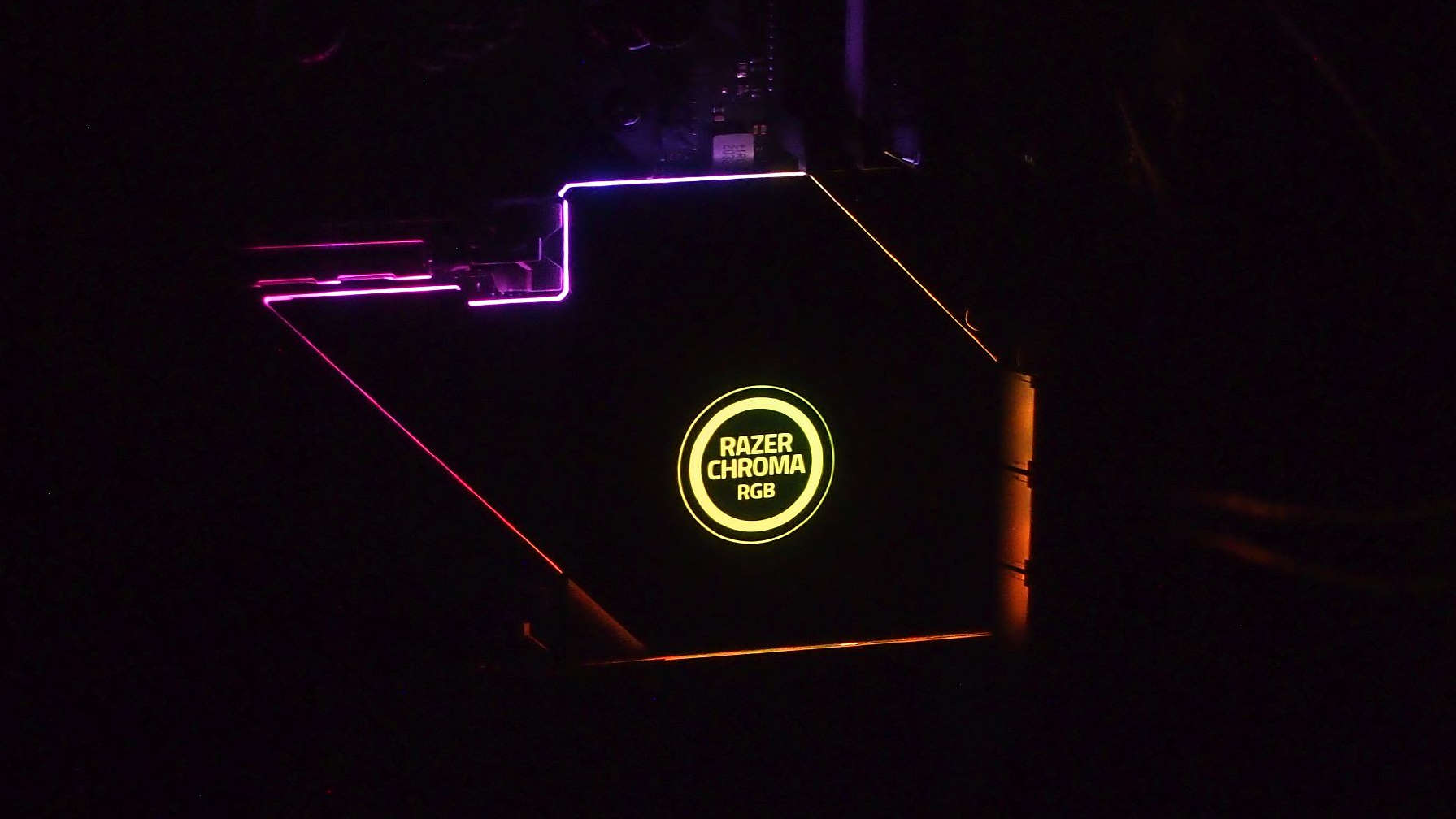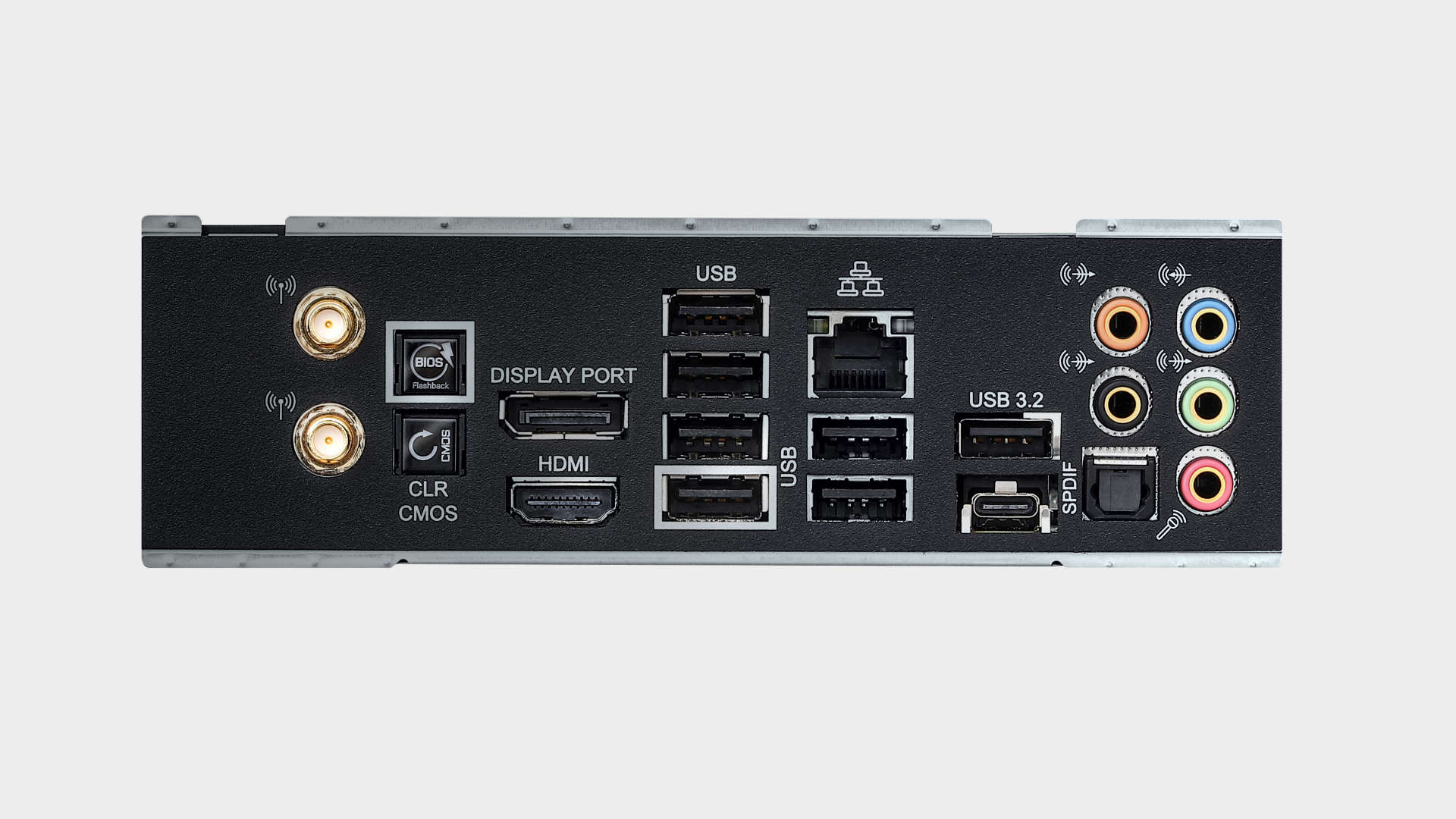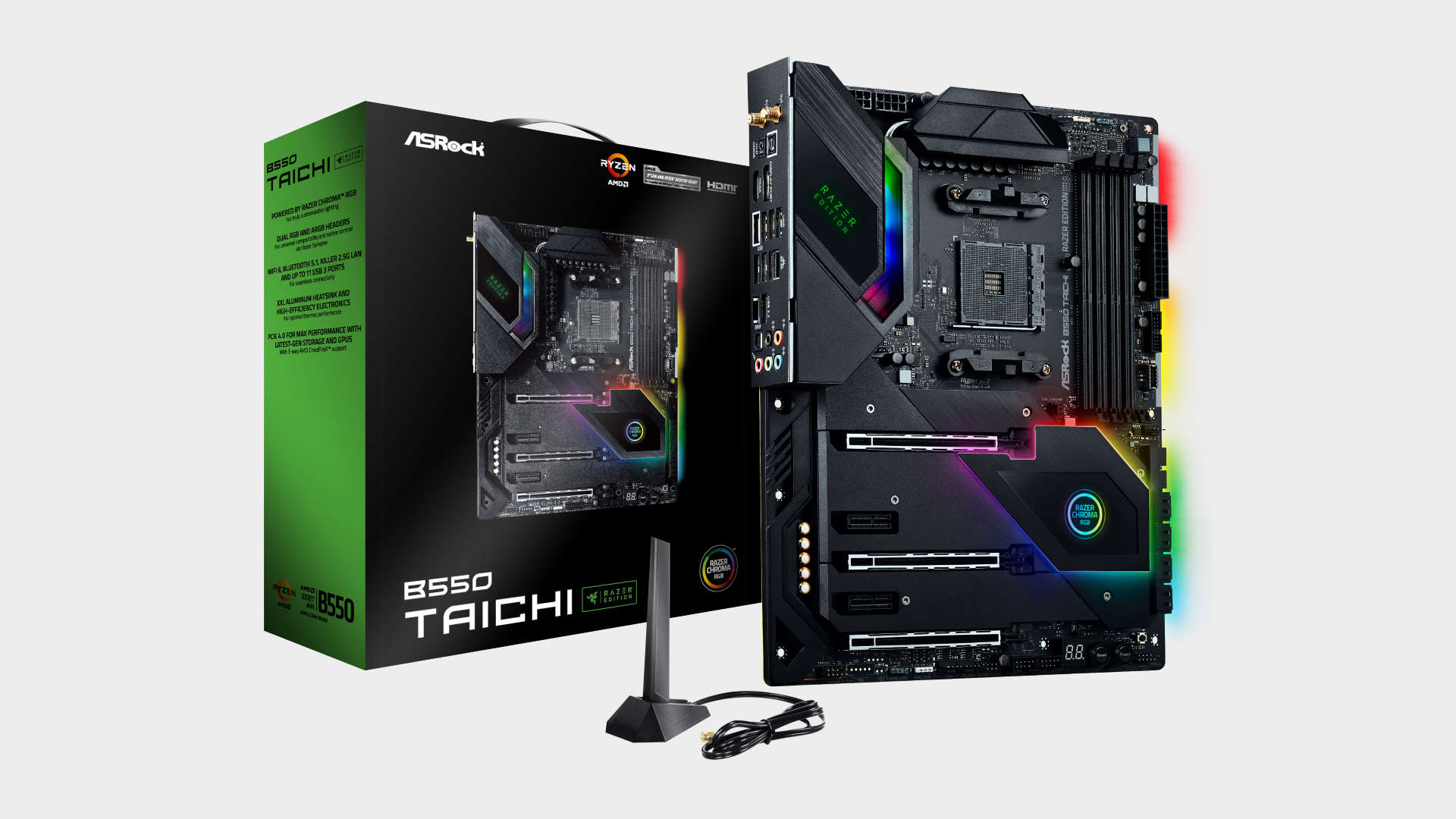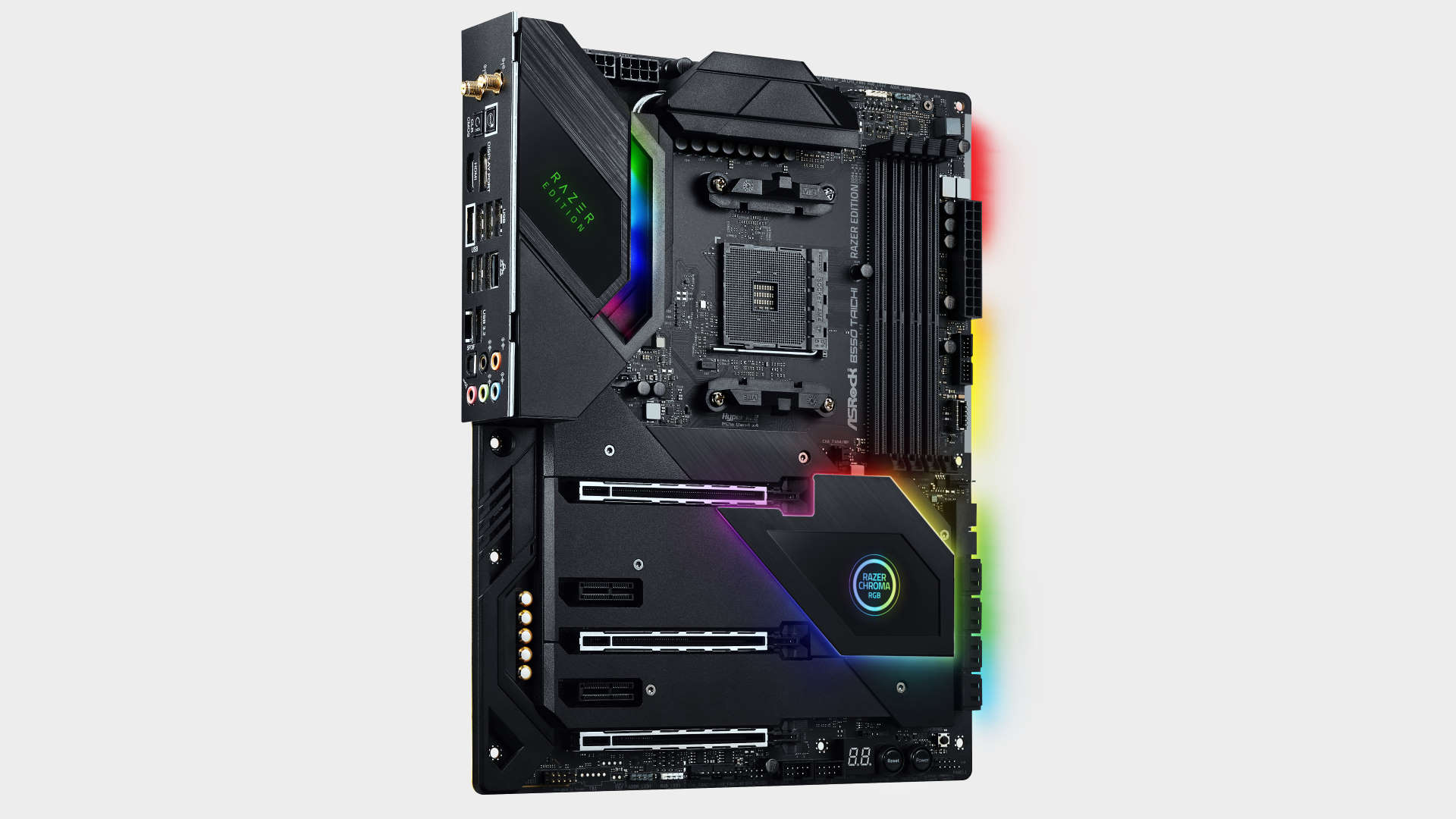Our Verdict
The ASRock B550 Taichi Razer Edition is a great B550 board, which lacks for very little, but faces tough competition from less-expensive X570 boards.
For
- Razer Chroma ecosystem support
- Strong VRM
- Good I/O and connectivity features
Against
- Many X570 boards can be had for less
PC Gamer's got your back
Since the debut of ASRock’s Taichi brand, we’ve been fans of its quality blend of price, performance, and features. It’s also one of few sub brands that doesn’t go all in on a ‘gaming’ theme, which is something many people appreciate. I know I do. With the Razer influence, however, that’s changed somewhat here. The traditional yin/yang and cog machinery aesthetic has been left off with the release of the B550 Taichi Razer Edition.
Form factor - ATX
Socket - AMD AM4
CPU support - AMD Ryzen 5000 Series, 4000 G-Series and 3000 Series Desktop Processors
Memory support - 4x DDR4 DIMM, up to 4733+ (OC)
Storage - 2x M.2; 8x SATA
USB - Up to 3x USB 3.2 Gen 2, 8x USB 3.1 Gen 1, 6x USB 2.0
Networking - Killer 1650x 802.11ax Wi-Fi; Killer E3100X 2.5G LAN
Audio - Realtek ALC1220 7.1 Channel HD Audio
Price - $299
This reinvented ASRock Taichi board features a minimalist, yet unmistakably premium appearance that integrates Razer Chroma RGB support. It sure is a lovely looking board, and if you’re invested into the Razer ecosystem, it’s a board you’ll definitely want to consider for a Ryzen 5000 series build.
Depending on which country you live in, at $299 USD the B550 Taichi Razer Edition may be the most expensive B550 board of all, it's certainly one of the best B550 motherboards. This isn’t some bargain basement cheapie that belongs in the budget bin. It’s a fully featured premium tier board with almost all the bells and whistles you’d expect from an enthusiast motherboard. Do you want a to run an overclocked 5950X with 64GB of RAM? Pair it with an Nvidia RTX 3090 or AMD 6900XT? Go right ahead.
As the name suggests, the biggest marketing talking point of the board is its support for the Razer Chroma RGB ecosystem. On the surface it’s just another flavour of RGB, but Razer does go beyond a typical implementation to include a greater range of effects while offering extensive customization with the Chroma Studio app. There’s also game integration, support for many external apps and Amazon Alexa integration. So, if you want to RGB your RGB, the chances are Chroma can do it.
It really does look lovely, though as is often the case, a graphics card will cover a big chunk of the PCH heatsink. But, with all the other RGB devices you’re likely to add to such a system, that’s not really a problem.
The other notable differentiator is the inclusion of Killer E3100 2.5G and AX1650 WiFi with DoubleShot support. The gaming community tends to have a bit of a love/hate relationship with Killer. A lot of it goes back to the clunky Manager app. The days of LAN gaming are behind us, but that would have been a great environment to test. Throw in all the leeching and you’d really stress your networking! The network outside of your PC and home is the true bottleneck these days. In the course of our testing the Killer networking operated exactly as it should.


The board is dominated by the subtle large black heatsinks featuring that stylish RGB lighting. RGB and ARGB fan headers can be seen just above the RAM slots, which themselves support up to 128GB at DDR4-4733. While that speed sounds good, actually you’re better off at 1:1 with the Infinity Fabric up to around DDR4-4000.
The primary M.2 slot is covered by its own heatsink. Thankfully this means you’re not required to remove the entire heatsink to connect a drive. First world reviewer problem perhaps? You also get eight SATA ports, something that’s becoming rarer these days even on high end boards as the switch the NVMe and M.2 accelerates. File hoarders take note.
Also noteworthy is the inclusion of a USB Type-C case header. At the bottom of the board you’ll find another set or RGB headers and power and reset buttons. This is becoming more and more common to many cases.
The VRM used on the ASRock Taichi Razer Edition is among the best you’ll find on a B550 board. A 16-phase setup with 50a mosfets will easily power an overclocked 5950X. Twin 8pin EPS connectors provide the juice.

The I/O is fairly typical of a premium board. We like that there are eight USB ports on the back panel, though curiously they aren’t color coded. There are two labelled USB 3.2 Gen 2 ports, four Gen 1 ports and a pair of 2.0 ports. (Side note: We really hope the USB naming mess is fixed with USB 4. It really is BS.) We’re not displeased to see HDMI 2.1 and DP 1.4a ports. If you’re a gamer with a discrete card it won’t matter, but a Zen 3 based APU with a monolithic die might surprise with its performance, so it’s better to have them than not.
As we often say when testing motherboards, the performance between them is usually within a margin of error or a couple of percent, and that’s the case again here. The B550 Taichi Razer Edition proved to be quite strong under most of the multi-threaded tests with our AMD Ryzen 9 5950X, often leading the other X570 and B550 boards we’ve tested to date. The board was more mid pack in the gaming tests, however.
Now that we’re familiar with the characteristics of our 5950X sample, it’s a lot easier to know what to expect from a board. We were again able to hit 4.5GHz with a 1.26v load but its gets very hot running 32 threads at 100%! Well into the 80’s in fact, so we call it quits there. The board has more headroom but the CPU just gets too hot even with a 360mm AIO. The VRM didn’t break a sweat with a 55°C maximum temperature recorded. That’s a long way from any danger or concern.
As far as memory overclocking goes, DDR4-4000 or 2,000 MHz with a 1:1 Infinity Fabric clock was easy. We have achieved higher on the Asus Crosshair VIII Dark Hero but that’s a top tier board. A good set of DDR4-3600 with your choice of capacity at a 1:1 Infinity Fabric ratio will sit right in the sweet spot.

The ASRock B550 Taichi Razer Edition is arguably right at the top of the B550 tree. Whether a B550 board costing as much as the Taichi Razer Edition is right for you may come down to how important RGB is to you and how many M.2 drives you plan to run. Many X570 boards are available at this price with three M.2 slots and feature more PCIe 4.0 general purpose lanes. There is an ASRock X570 Taichi Razer Edition, and that is some $100 more. Is it worth the extra? We’d say probably not unless your needs are specific.
The ASRock B550 Taichi Razer Edition can overclock as far as your cooling will allow, it can run fast memory, and it’s got Killer 2.5G LAN and WiFi 6 along with decent audio. It really does look great and will strongly appeal to RGB lovers. Ask yourself if you need extra M.2 slots or things like 10G LAN. If not, then this is a board that’s definitely worth considering. Even if for the aesthetic alone...
The ASRock B550 Taichi Razer Edition is a great B550 board, which lacks for very little, but faces tough competition from less-expensive X570 boards.

Chris' gaming experiences go back to the mid-nineties when he conned his parents into buying an 'educational PC' that was conveniently overpowered to play Doom and Tie Fighter. He developed a love of extreme overclocking that destroyed his savings despite the cheaper hardware on offer via his job at a PC store. To afford more LN2 he began moonlighting as a reviewer for VR-Zone before jumping the fence to work for MSI Australia. Since then, he's gone back to journalism, enthusiastically reviewing the latest and greatest components for PC & Tech Authority, PC Powerplay and currently Australian Personal Computer magazine and PC Gamer. Chris still puts far too many hours into Borderlands 3, always striving to become a more efficient killer.


